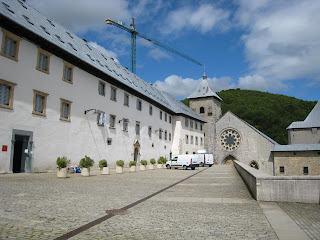Above is the monastery in Roncesvalles in the Spanish Pyrenees. We stayed there in 2008 and to our pleasant surprise, the accommodations were superb. In fact they top the list of all the places we've stayed in the three years we've walked in France and Spain.
In 2009 we stayed in the Benedictine monastery of Santa Maria Carbajalas in Leon, Spain. It was nice, but our room looked out on the courtyard seen in the foreground, which was the scene of all-night partying by crowds of young people.
Coming into the town of Samos, one gets this view of the Monasterio de Samos. Impressive as the facility is, we'd been warned away from staying there. Peeking into the cramped sleeping rooms, we discovered that we had received good advice.
We stayed in the huge Monasterio de San Martin Pinario in Santiago in 2009. The building covers almost an entire city block, but one day at breakfast we were joined by only four other guests.
Peg lounges in our rather basic room in the Monasterio de San Martin Pinario.
This is the Augustinian monastery of St. Nicholas de Barri in the tiny town of San Juan de Ortega. Built in 1150, it has accommodations for pilgrims. We didn't stay there, but stopped this year for a cup of coffee in the adjoining cafe bar.
All that remains of the Monastery of St. Felix de Oca is this gateway. Founded in the 9th century, it was once an important institution.
These ruins are what's left of the convent of San Anton, near Castrojerez in the Kingdom of Castilla y Leon. The order was famous for curing the disease St. Anthony's fire, now thought to be a form of ergotism, resulting from the eating of moldy bread. These ruins date from the 14th and 15th centuries. Unlikely as it might seem, a small facility tucked into one corner of the ruins was offering lodging for pilgrims when we visited in 2011. We took a pass on the opportunity and opted for more traditional accommodations.
The monastery of St. Zoilo, near the town of Carrion de los Condes now functions as a luxury hotel. Walking by this year we thought we might stop for a cup of coffee, but decided to walk on.
These ruins are nearly all that remains of the once-important Monasterio de San Facundo in Sahagun, Spain. Behind them is a much more modern clock tower. The monastery was founded in the mid 800s, but these ruins may be of more recent structures.
We missed others along the route, some having been reduced to little more than rubble, and many more probably re-purposed. Those that are still active as monasteries or convents are mostly reduced to mere handfuls of occupants.









